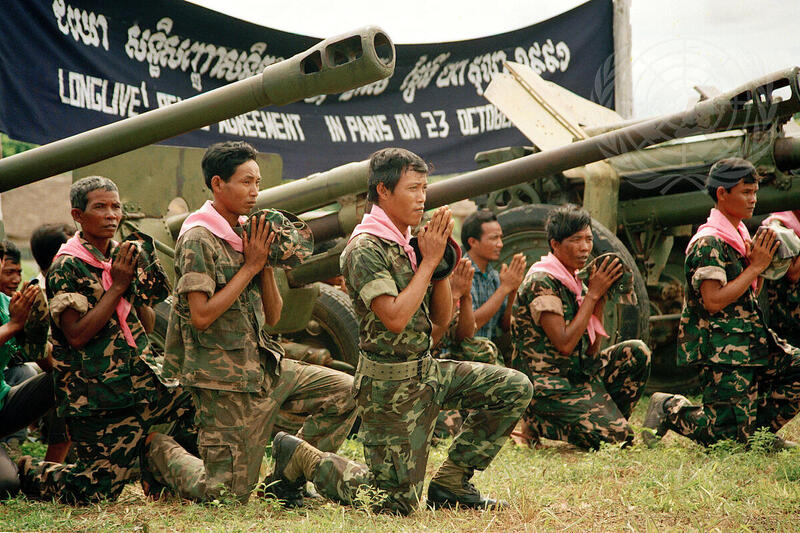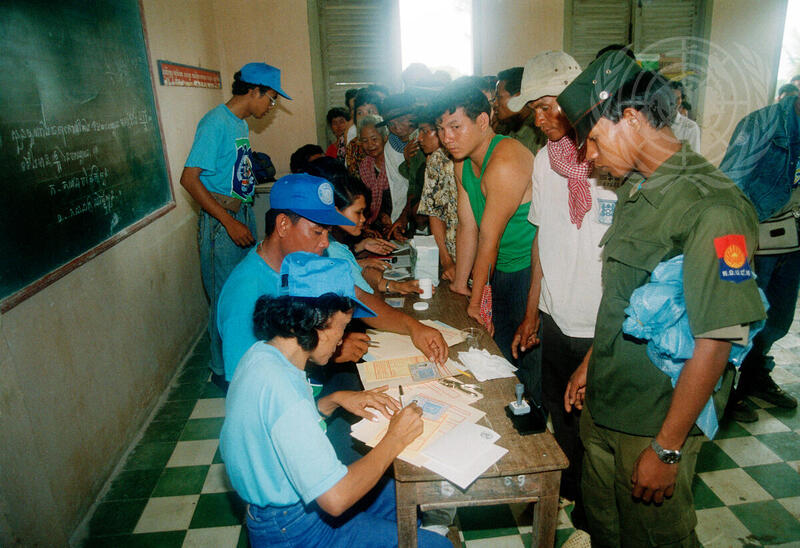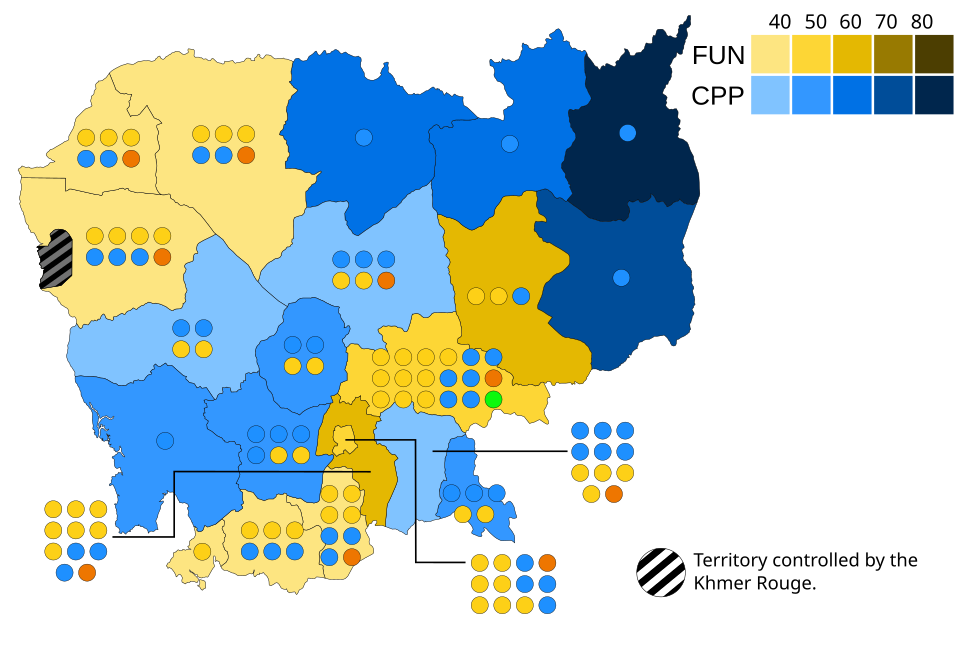OCR Specification focus:
‘the role of the UN; Paris Peace settlement (1991–1993) and the creation of a Cambodian Kingdom’
The final phase of the Cold War in Asia was shaped by United Nations peace initiatives and the Paris Peace Agreements, particularly in Cambodia, which sought to end decades of conflict and stabilise the region.
The Role of the United Nations in Cambodia
Background to UN involvement
By the late 1980s, Cambodia had been devastated by civil war, genocide under Pol Pot and the Khmer Rouge (1975–1979), and Vietnamese occupation (1979–1989). International divisions over Cambodia’s government prevented earlier solutions, but the end of the Cold War created conditions for multilateral intervention. The UN was tasked with mediating peace and overseeing a settlement that would restore Cambodian sovereignty.
UNTAC (United Nations Transitional Authority in Cambodia)
The United Nations created the UNTAC mission (1992–1993) to supervise peace, elections, and governance. This was one of the most ambitious operations in UN history.

Soldiers of the Khmer People’s National Liberation Front pray after surrendering their weapons under UNTAC’s demobilisation programme (July 1992). The scene exemplifies the UN’s role in enforcing the ceasefire and beginning disarmament across Cambodia. It highlights the human dimension of post-conflict peacekeeping. Source
Key responsibilities included:
Ceasefire monitoring: Supervising disarmament and the demobilisation of rival Cambodian factions.
Civil administration: Taking control of government functions such as policing, justice, and foreign affairs.
Humanitarian relief: Assisting refugees displaced by war, particularly those in camps along the Thai-Cambodian border.
Election organisation: Preparing for free and fair democratic elections in 1993.
Human rights protection: Monitoring abuses and establishing rule of law in a country scarred by mass atrocities.
UNTAC (United Nations Transitional Authority in Cambodia): The UN mission established under the Paris Peace Agreements to administer Cambodia temporarily, supervise elections, and ensure peace between rival factions.
UNTAC’s scale was unprecedented, involving around 22,000 personnel from over 100 countries, with both military and civilian components. It represented a turning point in how the UN approached post-conflict reconstruction.
The Paris Peace Settlement (1991–1993)
Negotiations leading to settlement
The Paris Peace Agreements, signed in October 1991, were the culmination of years of diplomacy. They brought together Cambodia’s four main factions:
The State of Cambodia (backed by Vietnam).
The Khmer Rouge.
The FUNCINPEC royalist movement, led by Prince Norodom Sihanouk.
The Khmer People’s National Liberation Front (KPNLF).
Other key actors included Vietnam, which withdrew its troops in 1989, and the major powers (China, the USSR, and the USA), whose cooperation made compromise possible after years of Cold War rivalry.
Key Provisions of the Paris Peace Agreements
Establishment of UNTAC to administer Cambodia.
Disarmament of all factions and cantonment of forces.
Return of refugees, with international support for reintegration.
Organisation of free elections under UN supervision.
Guarantees of sovereignty, independence, and neutrality for Cambodia.
Commitment to human rights and democratic governance.
These provisions aimed not just at ending conflict but at transforming Cambodia into a peaceful, self-governing state.
Challenges to implementation
The Khmer Rouge refused to disarm, undermining demobilisation plans.
Widespread banditry and insecurity in rural areas hindered reconstruction.
Limited resources and corruption weakened UNTAC’s civil administration.
Deep suspicion between factions persisted, raising fears of renewed conflict.
Despite these difficulties, UNTAC persevered with its mandate, adapting its approach to local realities.
Elections and the Creation of a Cambodian Kingdom
Elections of 1993
In May 1993, the UN organised Cambodia’s first democratic elections in decades.

Voters queue at a polling station in Phnom Penh during the 23–28 May 1993 election conducted under UNTAC supervision. The photograph illustrates the UN’s logistical and security role in delivering a nationwide ballot. It underscores the popular engagement that legitimised the transition. Source
Despite intimidation by the Khmer Rouge, voter turnout was over 90%, demonstrating strong popular support for peace and political change.
The results were:
Victory for FUNCINPEC, led by Prince Norodom Ranariddh.
The Cambodian People’s Party (CPP), led by Hun Sen, placed second.
The competing claims of authority threatened renewed conflict, but international mediation produced a coalition government.

A clean, labelled map showing constituency-level results of the 1993 Cambodian general election. It helps students connect the political outcome to geographic patterns of support following the UN-run vote. Source
Restoration of the monarchy
In September 1993, the Cambodian constitution was enacted, declaring the country a constitutional monarchy under King Norodom Sihanouk. This marked the creation of a new Cambodian Kingdom, intended to symbolise unity and national reconciliation after years of division.
Constitutional Monarchy: A system of government in which a monarch acts as head of state within the parameters of a constitution, often alongside a parliamentary system.
This restored Cambodia’s monarchy while embedding democratic principles, although practical governance soon came under strain due to factional rivalries.
Significance of the UN Role and Paris Peace Agreements
Successes
Ended decades of war and foreign intervention in Cambodia.
Enabled the return of refugees and some humanitarian recovery.
Introduced a constitutional monarchy and elections, laying the foundation for democratic governance.
Demonstrated the UN’s expanded role in nation-building after the Cold War.
Limitations
The Khmer Rouge remained active, continuing low-level conflict until the late 1990s.
The coalition government soon saw power struggles, with Hun Sen later consolidating control.
UNTAC’s ability to transform Cambodian political culture was limited, and corruption persisted.
Nevertheless, the UN’s intervention in Cambodia represented a landmark in international peacekeeping and set precedents for future missions in post-conflict societies.
FAQ
The end of the Cold War reduced superpower rivalry, making compromise possible.
The Soviet Union, weakened economically, wanted to reduce foreign commitments.
China shifted its strategy to normalise international relations and supported peace.
The United States saw an opportunity to stabilise Southeast Asia and prevent further regional conflicts.
All three worked together for the first time on Cambodia, giving the settlement unprecedented international backing.
Sihanouk was a unifying figure acceptable to most factions.
He was chosen to chair the Supreme National Council, representing Cambodia internationally during negotiations.
His symbolic return to the throne in 1993 helped legitimise the restoration of the monarchy.
Though his actual political power was limited, his prestige was crucial in reconciling groups after years of division.
The Khmer Rouge signed the agreement but refused to cooperate fully.
They boycotted the disarmament process, keeping their weapons and bases intact.
They denounced the 1993 elections as illegitimate and used violence to intimidate voters.
Their continued insurgency limited the effectiveness of UNTAC, prolonging instability.
UNTAC’s wide-ranging mandate stretched its resources.
Cambodia’s infrastructure had been devastated by war, making transport and communication difficult.
Refugee repatriation involved over 300,000 people, requiring extensive coordination with NGOs.
Monitoring elections in remote rural areas demanded creative solutions, including mobile polling stations.
These challenges highlighted the complexity of large-scale UN peacekeeping operations.
FUNCINPEC and the Cambodian People’s Party (CPP) shared power uneasily.
Prince Norodom Ranariddh of FUNCINPEC became First Prime Minister, while Hun Sen of the CPP took the role of Second Prime Minister.
This dual arrangement was meant to balance competing claims but created constant friction.
The CPP gradually consolidated control, with Hun Sen eventually emerging as the dominant figure in Cambodian politics.
Practice Questions
Question 1 (2 marks):
Which UN mission was established under the Paris Peace Agreements to administer Cambodia between 1992 and 1993?
Mark Scheme:
1 mark for identifying UNTAC (United Nations Transitional Authority in Cambodia).
1 additional mark for giving the full name correctly.
Question 2 (6 marks):
Explain two ways in which the Paris Peace Agreements (1991) attempted to create stability in Cambodia.
Mark Scheme:
Up to 3 marks for each explanation.
Award 1 mark for identifying a provision (e.g., UN administration via UNTAC, disarmament of factions, return of refugees, free elections, sovereignty guarantees, or human rights commitments).
Award 1 additional mark for describing the measure in more detail (e.g., UNTAC supervising elections and civil administration).
Award a further mark for explaining how this provision was intended to contribute to stability (e.g., elections to legitimise government, disarmament to reduce risk of renewed conflict).
Examples of valid points:
UNTAC administration and elections (identification) → UNTAC organised and supervised free elections in 1993 (detail) → this was intended to provide legitimacy and prevent further power struggles (explanation).
Disarmament of factions (identification) → required rival groups to hand in weapons and demobilise (detail) → aimed to reduce violence and ensure peace held during transition (explanation).

